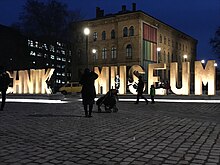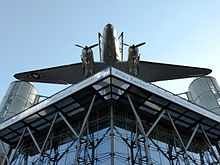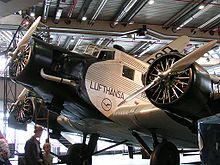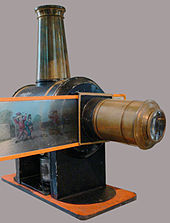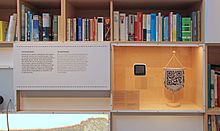German Museum of Technology Foundation Berlin
|
New building of the German Museum of Technology in Berlin, exterior view |
|
| Data | |
|---|---|
| place | Berlin ( Kreuzberg , Trebbiner Strasse 9) |
| Art | |
| architect | New building: Ulrich Wolff , Helge Pitz |
| opening | 1983 |
| Number of visitors (annually) | 635,382 (2019) |
| management |
Joachim Breuninger
|
| Website | |
| ISIL | DE-MUS-020415 |
The German Museum of Technology was opened in 1983 under the name Museum für Verkehr und Technik , which it held until 1996. The museum sees itself as the successor to various technical museums that existed in Berlin up until the Second World War , such as the Transport and Construction Museum (in the Hamburger Bahnhof ). The DTMB has 26,500 m² of exhibition space on the site of the former depot and freight depot of the Anhalter Bahnhof . The museum was visited by 635,382 people in 2019. The thematic focus is on the three major transport areas (rail transport, aviation and shipping, each with around 6000 m² of exhibition space). However, the museum would like to present all areas of technology as far as possible and therefore also has exhibitions, e.g. B. for printing, news, production and film technology. The museum sees itself as a cultural-historical technology museum that presents technical developments in their interactions with social, economic and political history.
History of the museum
The German Museum of Technology was founded in 1982 and opened in 1983. In the founding phase , it was not possible to keep the Transport and Construction Museum (VBM) in the Hamburger Bahnhof as a location for the DTM. The objects of the CBMs were in 1984 after taking over the S-Bahn in West Berlin by the SNB to the Dresden Transport Museum distributed and the DTM.
The museum is located near the Landwehr Canal in Trebbiner Strasse on a former commercial and railway site from 1874, on which the depot of the Anhalter Bahnhof with two round-robin sheds and the administration building of the Markt- und Kühlhallengesellschaft are located, not far from the former Luckenwalder Strasse post station of the Gleisdreieck underground station . This historical building ensemble is also an important object of the museum. In the interior of the historical buildings, some original details such as the capstan system in the locomotive shed or a horse staircase in the building of the market and cooling hall company have been preserved.
A 1996 begun new building was handed over to the Museum on 21 March 2001, the official inauguration took place on 14 December 2003. On the roof of urban prominently situated on the elevated railway building was on May 8, 1999, a raisin bomber of the type Douglas C-47 B Skytrain attached, which has since become a landmark of the museum.
After the completion of the first expansion phases with the construction of the new building, since April 16, 2005 the house has over 25,000 m² of exhibition space. On September 1, 1996, the name was changed to Deutsches Technikmuseum Berlin .
The German Museum of Technology Berlin Foundation was established in 2002, which also includes the Science Center Spectrum , which is also located on the former premises of the Anhalter Güterbahnhof. From 2002 to June 2016, the Archenhold observatory in Alt-Treptow and the Zeiss large planetarium in Prenzlauer Berg also belonged to the foundation. The Sugar Museum in Wedding , which previously belonged to the foundation independently, was reopened in 2015 as a department in the main building of the museum.
The founding director was Günther Gottmann . From 2003 to 2020 it was under the direction of Dirk Böndel . Joachim Breuninger has been heading the Museum of Technology since August 2020, which has been sponsoring the Berlin Center for Industrial Culture (bzi) together with the Berlin University of Applied Sciences (HTW) since 2011 . The bzi deals with Berlin's industrial heritage and uses various formats to make Berlin's industrial history accessible to a wider public.
Permanent exhibitions
Aerospace
The aerospace exhibition documents the development in these areas during the 20th century. The numerous exhibits include the only surviving Jeannin steel pigeon , built in 1914, from the early days of military aviation . The central object of this exhibition is the Junkers Ju 52 airliner , better known as Aunt Ju , which bears the name of Hans Kirschstein .
Rare memorabilia from a Lufthansa captain and a well-known sports pilot illuminate their everyday flying life. The two-seater aerobatic travel and training aircraft Arado Ar 79 shows the state of development in civil aircraft construction at Arado Flugzeugwerke before the Second World War .
The exhibition area on the Second World War deals with the establishment and fall of the German Air Force and shows how the National Socialists misused the fascination of flying for their own purposes. The wreckage of a Ju-87 dive bomber suggests the destruction potential of the aircraft as a weapon. The museum has had a Focke-Wulf Fw 200 rebuilt since 2003 , the type, which was used for civil and military purposes from 1937, is to be exhibited from 2025. The media station Mensch und Krieg shows the lives of former Air Force members based on six biographies . Since March 2008, a VFW-614 has been in the museum's possession as an example of German aircraft development after the Second World War.
An exhibition unit on aircraft technology illustrates the development and functionality of individual components such as the engine , landing gear or propeller . A glass airplane , a partially opened Arado Ar 96 from 1943, provides an insight into the complex technology of an aircraft.
The focus of the space sector is the German contribution to the development of rocket technology . The presentation begins with the fantasies and experiments of the early enthusiasts and ends with the appropriation of this technology for the armaments plans of the National Socialists . Drawings by eyewitnesses document the inhumane working conditions of the concentration camp inmates who were used in rocket production in Dora-Mittelbau .
In addition, the department contains the demonstration model of the German Aviation Collection Berlin , which was the most extensive collection and exhibition on the history and technology of aviation in the 1930s and 1940s.
From 1985 until his retirement in 2013, Holger Steinle was head of the aerospace department. Since then, the department has been headed by Heiko Triesch.
shipping
The Lifeworld Ship exhibition documents 10,000 years of shipping history with around 1,100 exhibits on three floors. Inland shipping is presented on the ground floor with several large objects such as the tugboat Kurt Heinz from 1901 from the Brandenburg region. A central object here is the 33 meter long coffee boat from 1840, which determined the architecture of this part of the museum. Technically quite undemanding, the boat salvaged from the mud of the Havel symbolizes the exhibition's concern to show the close relationship between man and ship, between cultural history and shipping history: a large number of ships of this type brought bricks to Berlin in the 19th century which the rapidly growing metropolis was expanded.
On the first floor, the theory of the ship is dealt with with questions about flow technology, longitudinal strength and the effectiveness of screw and wheel drive.
On the second floor, international ocean shipping is shown in its cultural and historical significance - it enabled the discovery of foreign continents, the transfer of culture and goods, but also war and colonization. On the upper floor are pleasure boats , about 50 ship models in 1:50 and scientific experiments exhibited that the German Technology Museum in an interdisciplinary research project in collaboration with the Institute of Naval Architecture and Ocean Engineering and the Laboratory of Hydraulic Engineering and Shipbuilding at the Technical University of Berlin conducted .
A separate cabinet is dedicated to the former Transport and Construction Museum and the former Institute and Museum for Oceanography, the two important predecessor institutions of the Shipping Department.
Rail transport

The railway exhibition Trains, Locomotives and People was one of the first to open in 1987/1988. It is housed in the double roundhouse of the former Anhalter Bahnhof depot from 1874. 40 original rail vehicles from the period from 1843 to 1960 can be seen here. There is also an abundance of historical models on a large scale of 1: 5, which come from the holdings of the former Transport and Construction Museum (in the former Hamburger Bahnhof ). From this forerunner institution originate u. a. also unique objects such as the open passenger car from 1843 or the Prussian express steam train S10 from 1911, which was cut open on one side in 1934 to illustrate how a steam locomotive works. It is demonstrated in motion twice a day.
Some of the vehicles acquired in the 1980s were left in their last operating condition or even damaged in order to preserve signs of use and changes as a document of the history of use. This is most evident in the case of the Prussian P8 series steam locomotive , which had been in service with the Polish state railway PKP since 1945 and was still used as a heating locomotive in a hospital after its use of the railway .
The exhibition is chronologically divided into 33 stations in the history of the railway . At the time of its establishment, it was the first museum presentation in German-speaking countries in which the history of the railroad was embedded in the respective cultural, economic and political-historical context. Therefore, in the section on the early days of the railways, for example, contemporary oil paintings from the cycle Life story of a locomotive by Paul Friedrich Meyerheim can be seen.

The role of the railroad in the deportations during the Nazi era was also discussed for the first time. Around a freight wagon as it was typically used in trains to the concentration camps, since 1988 in the exhibition unit "Deportations of Jews" with the Deutsche Reichsbahn 1941-1945 a . a. the fates of twelve Berliners murdered during the Nazi era are presented.
In the historic locomotive shed there is also a model railroad layout showing the tracks and buildings of the Anhalter passenger station , the freight yard and the railway depot as well as some surrounding buildings in the state of 1938 on a scale of 1:87 ( model size H0 ). It should clarify the former operational processes and building structures and enable visitors to recognize and classify the current building remains on the site of the museum and in the urban space.
A section of three tracks in the first locomotive shed is a reminder that the site was fallow for 30 years . Here are otherwise in growing Mediterranean usual stone Vistula and from Siberia native knotweed has just as common as the two herbs evening primrose and lady's mantle .
Alfred Gottwaldt was head of the rail transport department from 1983 until his retirement in 2014. Since 2016, the rail transport department has been part of the land transport collection area, which is headed by Lars Quadejacob.
The land transport collection area also includes road and municipal transport.
Road traffic
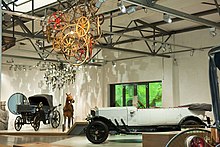
The collection on the subject of road traffic is one of the most extensive in the German Museum of Technology. More than 270 vehicles (from De Dion - steam car , built in 1883, to the NSU Ro 80 with rotary engine , built in 1972) and as many motorcycles, 400 bicycles and 20 horse-drawn carriages and sleighs are part of the inventory, which is also important individual collections such as the zündapp includes -Werkssammlung. This was acquired after the Zündapp bankruptcy in 1984; apart from 80 motorcycles, it includes the entire factory archive, including the photographic documentation of the production facilities from 1930 by Albert Renger-Patzsch . In the style of New Objectivity , some of these images were published in the style-defining photo book Eisen und Stahl (1930).
Since 2011, 39 vehicles from the collection have been shown in the exhibition Mensch in Fahrt . This is located on the loading street of the museum in a former shed of the Anhalter freight yard. It shows how automobility changed and changed everyday life and is also reminiscent of Berlin as the former center of the auto industry - based on now forgotten automobile companies whose designs as tricycles , small cars , streamlined and electric vehicles showed a wide range, but also, for example, with amphibious vehicles ended in “ingenious dead ends”.
In 2017, the German Museum of Technology began to look in its collections for objects that might have been wrongly confiscated , especially from Jewish owners, during the Nazi era . The collection of historic motor vehicles is the first to have been checked for provenance since then .
Numerous automobiles and two-wheelers in the collection are on permanent loan to domestic and foreign partner museums.
Municipal transport
The collection is located in the municipal transport depot for rail vehicles of the museum, in a former fast railcars hall of the Deutsche Reichsbahn is about two kilometers west of the museum area, housed. As a kind of viewing depot, it is only open to the public every year on September Sundays - with free admission. On these open days, the depot is connected to the main building of the museum by regular journeys on the connecting railway and by historic buses.
More than 50 vehicles from 150 years of local public transport are on display over an area of around 4,000 square meters, including 14 trams, four subway cars (including the first series from 1908 ) and three S-Bahn cars (including the legendary Stadtbahn type ) and 13 buses , such as the cityscape-defining Schnauzenbuses of the 1920s and 1930s. Cars such as an electric parcel delivery van from the Berlin company Bergmann , a Ford wood gasifier truck or a one-off streamline bus from the 1930s, built by a bus operator himself at the time, can also be seen.
The main railway vehicles housed here include u. a. a steam snow blower , the Prussian ES 2 electric locomotive and a Prussian compartment car that was used as a kindergarten for 80 years and also reminds of the Nazi opponent Erich Klausener .
Production techniques
Manual and industrial production technology from the 19th and 20th centuries is shown; for example the production of a suitcase .
In the exhibition on handmade jewelry production, production techniques such as embossing-pressing-punching, drawing-rolling, casting, grinding-polishing, guilloché- engraving, chain production and the manual techniques of the goldsmith's profession are presented, with which jewelry such as bracelets, rings, brooches, hoop earrings , Cufflinks, napkin rings were made. There will be demonstrations on historical machines such as a drop hammer for embossing , the centrifugal casting system for casting jewelry parts and the guilloche machine for decorating smooth surfaces with geometric patterns.
In the entrance hall there is a historical workshop with typical transmission-driven machine tools from the field of metalworking , which became standard in the course of the technical-industrial development in the 19th century and were used in smaller companies until the 1970s.
Gabriele Wohlauf was head of the department from 1985 to 2015. Today it is managed by Nora Lackner.
Textile technology
The textile technology exhibition shows textiles of various types and their production, with the machines being contrasted with the products made with them. Photo and slide presentations show the work in the documented companies.
The global division of labor with its relocation of industrial work to the south is discussed using the example of India . On the other hand, there is the development of high technologies in the north.
Worldwide relationships are shown using information technology, which has played a prominent role in textile technology since 1805. A ribbon loom is the central exhibit on the relationship between textile and data technology. The history of felt production , hat making and silk flower manufacture is also documented. The subject of textile construction is integrated into the subject of felt using the example of part of a yurt .
Computing and automation technology, communications technology

Konrad Zuse's life's work is the subject of an exhibition at the museum on computing and information technology. Almost all of the computers he built - from the Z1 to the Z31 with the variety of their additional devices and applications - can be seen in connection with the company's and family history, as well as the original book with the Plankalkül programming language . The other side of the technician is also shown: his abstract and expressive paintings.
The exhibition on the history of communications technology gives a cross-section of the collection area with main themes. Among other things, it shows the beginnings of German broadcasting in Berlin, a replica of the world's first electronic television system presented by Manfred von Ardenne in 1931, and the world's only functioning black and white television studio from 1958.
Hedwig Dorsch was head of the computing and automation technology department from 1983 until her retirement. Today the department is headed by Eva Kudraß.
Writing and printing technology, paper technology
The exhibition on the history of printing technology focuses on the process of letterpress printing . Visitors can print on a wooden press from the 17th century or on cast iron presses from the 19th century under the supervision of the demonstrators. On the Linotype you can set lines for a business card and then print them on a Boston platen press . The office technology area shows a selection from the extensive collection of office machines; visitors can try some of them for themselves.
In addition to the printing technology department, there is also the paper technology department with demonstrations of Asian and European papermaking. The focus of the exhibition is the artisanal paper scooping. The visitors can try their hand at the "white art" of paper scooping in groups by prior arrangement.
Energy Technology
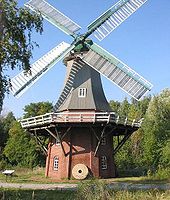
Recorded in April 2015
The field of energy technology includes a. three steam engines. In the entrance hall of the museum there is a steam engine that drives a whole ensemble of machine tools. It stands for the beginning of an independent energy technology. Two more steam engines are located in engine shed 1 and in the inner courtyard between this and engine shed 2.
Other objects in this area are two historical windmills in the museum's outdoor area - a Dutch and a post mill - which demonstrate pre-industrial energy conversion. Despite their ingenious mechanics, they form a contrast to industrial machine technology: the natural force of wind and the craftsmanship shape the construction. As a modern counterpart, a solar system sets a water feature in motion with the help of sunlight.
The extensive AEG archive, which also contains important designs by industrial design pioneer Peter Behrens , is also part of the energy technology field .
Transportation and civil engineering
The museum owns the extraordinary collection on hydraulic engineering of the former Transport and Construction Museum in Hamburger Bahnhof , which includes many functional, very large-scale and technically high-quality models as well as a large number of plans, paintings and maps .
Although only a small part of it can be shown, the exhibition gives an intensive picture of the various bridge forms, water regulation and lifting structures as well as port facilities and gives an impression of the engineering of canals , locks , roads and bridges .
Chemistry and pharmacy
The permanent exhibition “Pills and Pipettes” has presented historical and current aspects of the chemical and pharmaceutical industry since June 2010. On 400 m², it provides an insight into the industry using the example of the former chemical and pharmaceutical company Schering .
For the first time in Germany, this important branch of industry is presented in a large museum. Volker Koesling was the curator and head of the department until 2017. Among other things, the work techniques of a laboratory , work equipment from the glass pipette to the modern pipetting robot , the variety of chemical products, the basics of the pharmaceutical industry and the problems of drug safety are shown . Visitors can also become a pyrotechnician , so to speak , and assemble and ignite a virtual firework .
One of the main topics is the discovery of sex hormones and their use as contraceptives in the “pill” developed by Schering, with the consequences for sexuality and family planning . The accompanying volume Pills and Pipettes: How Chemistry and Pharmacy Determine Our Lives was published for the exhibition .
Scientific instruments
Since the opening of the permanent shipping exhibition in December 2003, the area of navigation instruments can be seen again in an expanded form.
Other areas such as microscopy , spectroscopy , time measurement or the extensive collection of scales and weights are initially stored in the depot. They are the basis for a planned larger presentation in the course of the further expansion of the museum.
History of film technology
This area of the museum presents the history of film technology from the magic lantern to the modern film projector , from the medieval peep box to the optical gadgets of the 19th century such as the miracle drum , the activity or the fast viewer to the cinema and video films of the 1980s.
The several hundred objects include the ox-eye from 1750, peep boxes and dark chambers , Kine-Messter cameras and a tank cinema from the early days of the German film industry, professional recording cameras from all eras, amateur recording devices from 1898 to modern video cameras , and a film set diorama Original equipment and an editing room. Visitors can try out many devices from previous and cinema history and functioning replicas of early film pioneers. Historical film clips such as a copy of an original Edison film about the execution of Maria Stuart , films about the Berlin pioneers Max Skladanowsky and Oskar Messter as well as early amateur films can be viewed.
Historic brewery
In the museum park, in a former warehouse of the Nuremberg Tucher Bräu AG , a historic brewery has been set up that shows the transition from artisanal to industrial beer brewing.
The focus of this exhibition is on the explanation of the classic beer production process, with the technical equipment from the beginning of the 20th century. The center of the brewery is the brewhouse with its brewing vessels from 1909. It can be reached via historical, cast-iron stairs and, with its copper containers, gleaming fittings, handwheels and pipes, is a special technical monument.
Outdoor area / museum park
Some of the facilities in the former depot were reconstructed in the 1980s. In addition to parts of the track system, this also includes an inclined coal elevator, two water cranes and a coal crane, some of which are used to stock the steam locomotives of historical special trains visiting the technology museum.
The lush vegetation of the area, which was created between the closure of the depot in 1952 and the 1980s, was left partially deliberately in order to document this re-appropriation by nature, but also to protect the great variety of plants. In this biotope , remains of the original facilities of the railway depot can still be made out, e.g. B. the coal bane made of concrete, which is parallel to the paved area today.

The outdoor area of the museum, known as the 'Museum Park', has been continued in the urban space in the surrounding park at Gleisdreieck since 2011 .
Historical archive and library
The historical archive , the library and the picture center are service facilities for museum visitors as well as for the staff of the house.
The extensive holdings on the history of technology and industry with a focus on Berlin include the AEG , Borsig or Zündapp archives, the Stiasny and Feldhaus archives as well as the VDI and Chamber of Technology (KdT) libraries and parts the library of the former Oceanography Museum .
Communication and information networks
Since September 2015 there has been the permanent exhibition Das Netz in Ladestrasse . People, cables, data streams . In contrast to the museum's traditional collection- related exhibitions, Das Netz takes a thematic approach. The permanent exhibition asks what influence communication and information networks have and had on people's lives, thoughts and actions. Starting with the Internet, a historical arc is struck to telegraphy into the 19th century.
Special exhibitions
The technology museum regularly shows exhibitions on various topics.
- Special exhibitions 2009:
- Gleisdreieck 1978. Photographic securing of evidence in old West Berlin
- The children's mission. What we can do about climate change today
- Obstinacy with fuse ignition , special exhibition on the occasion of the fall of the Berlin Wall 20 years ago
- mathema. Is mathematics the language of nature?
- VEB Pentacon Dresden - The last day of production at Praktica
- Helmholtz Association: Chamber of Wonder Science
- Travel food. Eating and drinking around the railroad (since 2004)
- Special exhibitions 2010:
- Global Players - Toys from Africa
- Faces of India - people in front of the camera
- IT and media art Art of Engineering , finalist contributions to the interdisciplinary competition by Ferchau Engineering GmbH in the Technology Museum
- Max Krajewsky - photochronist of Berlin's building history , photo exhibition
- The Flettner rotor - a failed innovation?
- Rusty pictures? Industrial photography in the GDR 1990/91
- Preservation and decay , comparison of contemporary works with selected holdings from the photo archive of the German Museum of Technology Berlin
- Special exhibitions 2011:
- They are at our feet - street covers in Berlin
- Underwater photography - diving with your camera
- Everything is water - art photographs by Charlotte Sonntag , photo exhibition
- Noble papers from Gmund - a paper factory introduces itself
- Chausseen - avenues - milestones - street houses. Contemporary witnesses of the economic and cultural development of Brandenburg and Berlin
- Special exhibitions 2012:
- Ship propellers: monumental works of art
- The newcomers - new settlers in the Uckermark
- Special exhibitions 2013:
- Between heaven and hell - children photograph their Berlin
- WINDSTÄRKEN , special exhibition on the topic of wind in the museum and museum park
- Special exhibitions 2014:
- Gleisdreieck - A railway area in Berlin , photo exhibition
- Orenstein & Loewe: 20 big names in the history of technology
- Peter Behrens - buildings for the AEG , photo exhibition
- BERLINER LINSE 2013 , photo exhibition
- Special exhibitions 2015:
- Max de Esteban: On the offense , photo exhibition
- Hans Schaller, aviation photographer, photo exhibition
- 30 years in 30 photographs
- Pictures of tomorrow , interactive panorama
- Beyond the blinds , photo exhibition
- Special exhibitions 2016:
- ALL.day! - the INNOspaceExpo
- Fachwerk (s) - renaissance of precious metals
- Man at work , photo exhibition
- Technology for Hitler's Olympia , photo exhibition
- Special exhibitions 2017:
- From department store to Tacheles , photo exhibition
- Oceans - expedition to unexplored depths
- 100 years of Zündapp: industrial photos by Albert Renger-Patzsch , photo exhibition
- Erich "Desert" Hoffmann and the Berliner Radsport , photo exhibition
- Special exhibitions 2018:
- Sea mark!
- Mathematics of the planet earth
- Parked - cars from the museum depot
- The carrier pigeon as a photographer , photo exhibition
- Paris music engraving , photo exhibition
-
40 years of Germans in space. Two states, eleven space travelers , one hundred objects :
September 20–30. December. - Architectura navalis - floating baroque
- Stormy seas and surf , photo exhibition
Connecting railway
The museum has its own connecting railway with a length of around 1.8 kilometers. This connects the museum grounds with the depot halls at the Monumentenbrücke in the Schöneberg district . In this way, historical vehicles can be exchanged between the depot and the rail transport exhibition in the museum's historical locomotive sheds.
At the Monumentenbrücke depot there is also a transfer point to the Deutsche Bahn AG rail network , which leads directly to the north-south long-distance railway . The museum receives new vehicles via this connection, and historical special trains can also travel directly to the museum premises, where there is a platform.
There are also free shuttles between the main building and depot stops on every September Sunday. The diesel locomotive of the type MB 10 N built by Orenstein & Koppel in 1967 and a historical express train car from 1934 (type C4i-34a) are used. The route leads through the park at Gleisdreieck, which opened in 2011, and over one of the historic Yorck bridges . The connecting railway on the museum premises also includes a functioning water crane , a slag pit and the two turntables in front of the locomotive shed, each with a diameter of 23 meters. The connecting railway is operated by two full-time train drivers.
Support association
Citizens of Berlin and representatives of traffic and technical facilities founded the Society for the Reconstruction of a Transport Museum in Berlin e. V. , since the corresponding museums were not available due to the consequences of the war. After a display collection was opened in the rooms of the Urania in May 1964 , the association was given a new name: Verkehrsmuseum Berlin e. V.
In 1970 the Berlin Senate commissioned the Friends' Association to manage the project for the establishment of a state museum for traffic and technology. After the appointment of the director, Günther Gottmann , in 1980, the founding of the museum was celebrated on May 13, 1982 in the Ernst-Reuter-Haus .
The association has been called Friends and Supporters of the German Museum of Technology Berlin e. V. (FDTM). He supports the German Museum of Technology through acquisitions and a wide range of museum-related activities, e. B. through the weekly regular one-off operation of the railway model "Anhalter Bahnhof" (locomotive shed 2) in the nominal size H0 .
Remarks
- ↑ The aircraft with the serial number 7220 was given to the Museum of Technology by the Spanish government in the 1960s for a symbolic purchase price. On July 29, 1965, it was named Carl August von Gablenz during the International Transport Exhibition in Munich . Later, during a restoration, the aircraft was given its original name Hans Kirschstein , under which Deutsche Lufthansa AG originally put the aircraft into service in 1941.
Web links and literature
- German Museum of Technology Foundation Berlin
- Information sheet on the area at Gleisdreieck (PDF) from the Berlin Center for Industrial Culture
- Technology museum
- Support association
- The museum
- German Museum of Technology Berlin. Info from the friends and sponsors of the German Museum of Technology Berlin e. V. Berlin 1984 ff (magazine of the FDTM association)
- Dirk Böndel: 25 years of the German Museum of Technology Berlin. In: MuseumsJournal 4, 22nd year, October – December 2008, pp. 54–56.
- Pichler, Gerhard; Guggisberg, Roland: German Museum of Technology Berlin - technology of the future is combined with the history of technology . In: Stahlbau, 67th vol. (1998), H. 7, pp. 580-591.
Individual evidence
- ↑ New on www.sdtb.de, called on 29 January 2011th
- ↑ [1] , accessed on July 19, 2020.
- ↑ Numbers and facts. In: Foundation German Museum of Technology Berlin. Retrieved December 21, 2016 .
- ↑ Record number of visitors to the German Museum of Technology and Spectrum. Retrieved July 19, 2020 .
- ^ German Museum of Technology Berlin (ed.): German Museum of Technology. Museum guide . Berlin 2015, ISBN 978-3-9801602-3-0 .
- ^ Günther Gottmann: Concept sketch by the director for the Senate bill for the establishment of the Museum for Transport and Technology . In: Museum for Transport and Technology Berlin (Ed.): A guide to the collections . 2nd Edition. Berlin 1985, p. 138 .
- ↑ Volker Koesling, Florian Schülke: Mensch, Technik! A journey of discovery through the cultural history of technology. Ed .: Foundation German Museum of Technology Berlin. Koehler & Amelang, Berlin 2013, ISBN 978-3-7338-0395-7 , pp. 9 ff .
- ↑ Skytrain over the Landwehr Canal - extension for the Berlin Museum of Technology completed. At: baunetz.de , March 20, 2001
- ↑ Finally inaugurated - German Museum of Technology opened in Berlin. At: baunetz.de , December 12, 2003
- ↑ Successful landing: raisin bomber moored at the technology museum. In: Berliner Zeitung , May 10, 1999
- ↑ From balloon to airlift , on stern.de
- ^ Science Center Spectrum
- ↑ Archenhold Observatory
- ↑ Zeiss large planetarium
- ^ German Museum of Technology: The German Museum of Technology Berlin Foundation. Retrieved August 21, 2018 .
- ^ Sugar Museum
- ^ German Museum of Technology: Ship Lifeworld. Retrieved August 20, 2019 .
- ↑ Günter Pohlandt: Berlin is built out of a boat. In: Zeitschrift Modellbau-heute 1/1987 . Military publishing house of the GDR, Berlin 1987.
- ↑ Uwe Nussbaum: Railway models. Treasures from the Transport and Construction Museum . In: Berlin contributions to the history of technology and industrial culture . tape 17 . Nicolaische Verlagsbuchhandlung, Berlin 1998, ISBN 3-87584-694-X .
- ^ Dierk Lawrenz: The series 17 in the German Museum of Technology in Berlin. In: Railway courier . Retrieved August 20, 2019 .
- ^ Alfred Gottwaldt: Trains, Locomotives and People. Railway history in 33 stations. A catalog . 2nd Edition. Stiftung Deutsches Technikmuseum Berlin, Berlin 2009, ISBN 978-3-9801602-9-2 , p. 101 f .
- ↑ Rail transport. Deutsches Technikmuseum Berlin, accessed on November 9, 2009 .
- ^ "Deportations of Jews" with the Deutsche Reichsbahn 1941–1945. Deutsches Technikmuseum Berlin, accessed on November 9, 2009 .
- ↑ Sebastian Werner: "The museum can grow". An interview with Lars Quadejacob, Head of Land Transport Collection at the German Museum of Technology in Berlin . In: Railway courier . No. 5/2017 . Eisenbahn-Kurier-Verlag, Freiburg 2017, p. 50-55 .
- ^ Zündapp on the way to China - Zündapp Museum in Berlin. Newspaper report (PDF; 5.1 MB)
- ^ Ulrich Kubisch: Zündapp and the German Museum of Technology. A personal review by the former head of the collection . In: Deutsches Technikmuseum 4/2016 . Berlin 2016.
- ↑ Lars Quadejacob: Deserted Modern. Hundred years of Zündapp: industrial photos by Albert Reanger-Patzsch . In: Deutsches Technikmuseum 1/2017 . No. 1 . Berlin 2017, p. 42-44 .
- ^ German Museum of Technology: Provenance Research. Retrieved August 21, 2019 .
- ^ German Museum of Technology: Schnauzenbusse and Cadillacs. Retrieved August 20, 2019 .
- ↑ Reinhard Demps / Georg Goetze: Collections of historical Berlin buses . In: Deutsches Technikmuseum 3/2005 . Berlin 2005, p. 8-13 .
- ↑ Lars Quadejacob: The car in the forest. An unusual memorial for a Nazi opponent . In: Communications from the Association for the History of Berlin . tape 3/2019 . Berlin 2019, p. 465 f .
- ↑ Eckart Roloff and Karin Henke-Wendt: From the green pharmacy to the birth control pill (The exhibition pills and pipettes in the German Museum of Technology). In: Visit your doctor or pharmacist. A tour through Germany's museums for medicine and pharmacy. Volume 1, Northern Germany. S. Hirzel, Stuttgart 2015, pp. 31–32, ISBN 978-3-7776-2510-2 .
- ↑ Ed. By Volker Koesling, Koehler & Amelung, Leipzig 2010, ISBN 3-7338-0377-9 .
- ^ Historical archive of the German Museum of Technology Berlin Foundation
- ^ Library of the German Museum of Technology Berlin Foundation
- ^ Website of the permanent exhibition Das Netz. People, cables, data streams : sdtb.de , accessed on October 11, 2016.
- ↑ Special exhibitions on the website of the German Museum of Technology. Retrieved March 29, 2018 .
- ↑ Homepage DTM with an overview of the special space exhibition .
- ↑ Deutsches Technikmuseum Berlin: Please get in and close the doors. Retrieved September 6, 2019 .
- ↑ Hendrik Bloem: Moving new things in Berlin . In: Journal of Railway Romanticism . 3/2018 edition. VG-Bahn, Fürstenfeldbruck June 2018, p. 30-40 .
- ^ The chronicle of the association ... FDTM, accessed on November 15, 2009 .
- ^ Friends and sponsors of the German Museum of Technology Berlin e. V.
Coordinates: 52 ° 29 ′ 55 ″ N , 13 ° 22 ′ 39 ″ E

